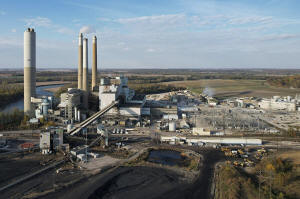Trump pumps coal as answer to AI power needs but any boost could be
short-lived
 Send a link to a friend
Send a link to a friend
 [January 25, 2025] By
MEAD GRUVER and MATTHEW BROWN [January 25, 2025] By
MEAD GRUVER and MATTHEW BROWN
CHEYENNE, Wyo. (AP) — President Donald Trump’s promise to go all in on
fossil fuels includes praise for coal, a reliable but polluting energy
source that's long been in decline.
Trump this week suggested coal can help meet surging electricity demand
from manufacturing and the massive data centers needed for artificial
intelligence.
“Nothing can destroy coal. Not the weather, not a bomb — nothing," Trump
told the World Economic Forum in Davos, Switzerland, by video link
Thursday. “And we have more coal than anybody.”
Yet energy experts say any bump for coal under Trump is likely to be
temporary since natural gas is cheaper and there’s a durable market for
renewable energy no matter who holds the White House.
“It's kind of been shown over the last three administrations even the
president of the United States can't change markets, the trend for
coal," said University of Wyoming economics professor Rob Godby. "It
might lead to a reprieve."
Here's a look at the outlook for coal during Trump's second term:

AI WILL REQUIRE MORE ELECTRICITY
Efficiency gains have plateaued electricity demand in the U.S. for 15
years, but that's changing. More manufacturing, more electric vehicles,
and energy-hungry computing centers necessary for artificial
intelligence are poised to strain the system.
Electricity demand for data centers alone will increase 10-20% per year
through 2030, while manufacturing of batteries, solar cells and
semiconductors will require additional gigawatts of new power over the
next four years, predicted Chris Seiple with analyst firm Wood
Mackenzie.
While the tech industry is used to churning out new products to meet
changing demand, electric utilities are not. Power plants and
transmission lines often take decades of planning.
“The Trump administration is a four-year administration. It’s really
difficult for utilities to make investment decisions in four-year
windows,” Godby said.
A REPRIEVE FOR SOME OLD COAL PLANTS
Trump this week issued executive orders calling for prioritizing energy
development, such as by lifting regulations that impede development of
fossil fuels.
That could lead to repeals of President Joe Biden's power plant
pollution regulations and an end to some policies that support
renewables.
Environmentalists cringe at the implications for climate change —
electricity generation accounts for one-quarter of U.S. carbon
emissions, according to the EPA — but miners welcome the shift.
Unlike solar and wind power, which are subject to vagaries of sunlight
and weather unless they're paired with battery storage, coal-fired
electricity can run around the clock with only periodic downtime for
maintenance. Supporters say the nonstop power from coal meets the needs
of technology facilities.
But while tech firms that want off-the-grid power might invest in a
“dirt cheap” coal-fired power plant, Godby said, such plants need time
to fire up. They aren't very good for the kind of on-the-spot backup
power Trump was referring to in addressing the Davos conference.
Surging demand is expected to prompt delays in plans to retire
coal-fired power plants. That's already been happening with plants in
Maryland, Indiana and Illinois.
For utilities, Trump's comments were “a blank check to do whatever you
want” in the short term despite prior attempts to address carbon dioxide
emissions and expand renewables, said S&P Global analyst Dan Thompson.
But Thompson noted three of the companies driving the data center boom —
Google, Amazon and Microsoft — are the biggest corporate purchasers of
renewable power and have made commitments to reach carbon neutrality.
[to top of second column] |

AES Indiana Petersburg Generating Station, a coal-fired power plant,
operates in Petersburg, Ind., on Wednesday, Oct. 25, 2023. (AP
Photo/Joshua A. Bickel, File)
 That suggests a reprieve, not a
comeback, for coal.
“It’s natural gas that will benefit the most from rising electricity
generation,” Seiple said. “It’s very unlikely we will see new coal
plants due to how expensive they are.”
COULD TRUMP TAP PUBLIC COAL RESERVES?
The U.S. has some of the largest coal reserves in the world — enough
to last more than 400 years at current mining rates, according to
the Energy Information Administration.
The industry relies heavily on reserves on public lands in the West,
particularly the Powder River Basin of Wyoming and Montana.
Sales of those reserves have long been politically contentious.
Trump in his first term reversed a moratorium on government coal
sales imposed under former President Barack Obama.
The Biden administration also sought to ban new coal sales in the
closing days of his administration. The decision ws projected to
result in mines depleting their federal coal reserves as early as
2035 — decades earlier than if leasing continued.
When Sen. Jon Barrasso asked Trump Interior secretary nominee Doug
Burgum about the ban during his confirmation hearing, Burgum replied
he would “absolutely” work with the Wyoming Republican to reverse
the ban.
Burgum also pledged to work with Montana Republican Sen. Steve
Daines to advance pending coal mine expansion permits in the
lawmaker’s state.
“We have a shortage of electricity and especially we have a shortage
of baseload. We know that we have the technology to deliver clean
coal,” Burgum said. He referenced efforts at a coal to gas plant in
North Dakota — where he was governor — to capture and sequester
carbon dioxide that would otherwise warm the planet.
Research has shown carbon capture is feasible and useful to boost
aging oil field production. Scientists have questioned the
practicality of commercial-scale, permanent sequestration of carbon
dioxide from burning coal and other fossil fuels.
US COAL EXPORTS RISE
Global coal production was expected to an all-time high last year,
approaching 10 billion tons (9 billion metric tons), according to
the International Energy Agency.

The biggest demand is in Asia, where countries including China
continue to build new coal-fired power plants as their economies
expand.
U.S. coal companies have sought to capitalize on that growth by
exporting more coal. They've been hindered by a lack of port access
on the West Coast.
To get around opposition to new ports, Republicans during Trump’s
first term considered but never acted on a plan to use West Coast
military bases or other federal properties as fossil fuel export
sites.
U.S. exports last year were expected to top 100 million tons for the
second year in a row. Top destinations included India, China,
Brazil, Japan and the Netherlands.
“There is strong global appetite for coal and U.S. producers are
ready to answer that need,” said National Mining Association
president Rich Nolan.
Overall U.S. coal production is forecast to continue declining.
“The long-term trend is hard to get out of," Godby said.
All contents © copyright 2025 Associated Press. All rights reserved |